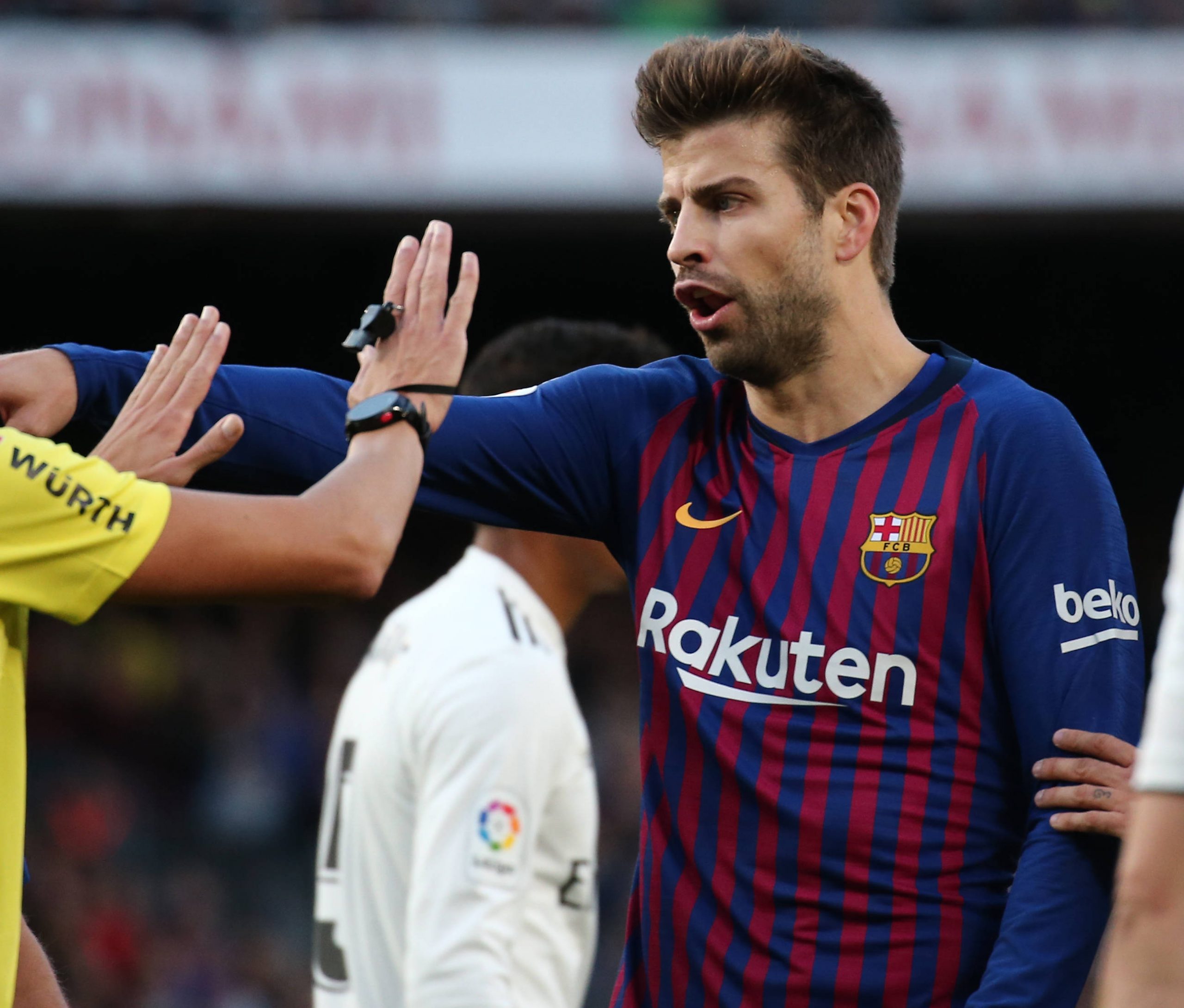Despite a knockout performance against Real Madrid this weekend, across this season there seems to have been a notable dip in Barcelona’s performance levels. We take a look at what’s happening. After ten games, Barcelona are top of the La Liga table. Alternatively, after ten games, Barcelona are seven points worse off than at this stage last season. Two things can be true at once. It’s worth mentioning that the Camp Nou faithful are famously quick to describe anything below perfection as a crisis, and last year’s almost unbeaten season was a feat unlikely to be repeated. Still, there are legitimate questions about their performance level so far this season.. A look at their expected goal trendline shows that the issues didn’t arrive from nowhere this season: (all data current as of 21st October) 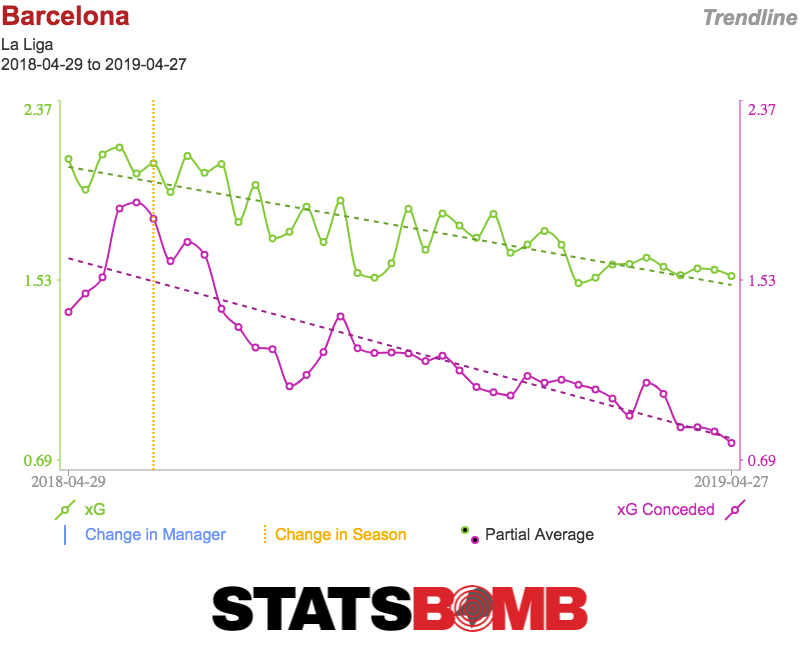 That’s a fairly alarming rise in xG conceded over the second half of last season. The crucial context is that Barcelona were so far ahead in the league at this point that these fixtures were not usually “must win” games, but you still don’t want to see your defence suddenly deteriorate at this rate. Manager Ernesto Valverde seems to have found a way to restore a level of solidity on the defensive side of the ball this year, but it has come at an attacking cost. The 1.87 expected goals per game that the team is currently creating remains the best in the league, but it is a significant step down from last year’s stratospheric figure of 2.14. When averaging out for the whole season, the expected goals conceded don’t look as different (1.18 per game this year vs 1.06 last season), but it still puts their defence as merely the ninth best in the league. So we have an attack that is down significantly but still the best in Spain, and a defence that has come close to maintaining last year’s level, yet is barely better than league average. Clearly, Barcelona’s issues need to be examined on both sides of the ball.
That’s a fairly alarming rise in xG conceded over the second half of last season. The crucial context is that Barcelona were so far ahead in the league at this point that these fixtures were not usually “must win” games, but you still don’t want to see your defence suddenly deteriorate at this rate. Manager Ernesto Valverde seems to have found a way to restore a level of solidity on the defensive side of the ball this year, but it has come at an attacking cost. The 1.87 expected goals per game that the team is currently creating remains the best in the league, but it is a significant step down from last year’s stratospheric figure of 2.14. When averaging out for the whole season, the expected goals conceded don’t look as different (1.18 per game this year vs 1.06 last season), but it still puts their defence as merely the ninth best in the league. So we have an attack that is down significantly but still the best in Spain, and a defence that has come close to maintaining last year’s level, yet is barely better than league average. Clearly, Barcelona’s issues need to be examined on both sides of the ball.
Defence
The aforementioned uptick in expected goals conceded towards the end of last season seemingly did not go unnoticed by Valverde, who has made some very noticeable tactical tweaks without the ball. In terms of raw shot numbers, this has been a big success, with the Catalan side now conceding just 8.67 shots per 90 minutes compared to last year’s figure of 11.71. Suppressing the volume of shots conceded is a telltale sign of a high pressing system, and Barcelona have indeed seen an uptick on StatsBomb’s high press metric, up to 48.76 from last year’s 47.50 (a more significant increase than it sounds). This pressing increase has also been noted by friend of the site Michael Caley, with his data showing that Barcelona are now quicker to break up opposition possessions. Looking at their defensive activity map, Barcelona are now very clearly much more aggressive in the opposition half than their own. 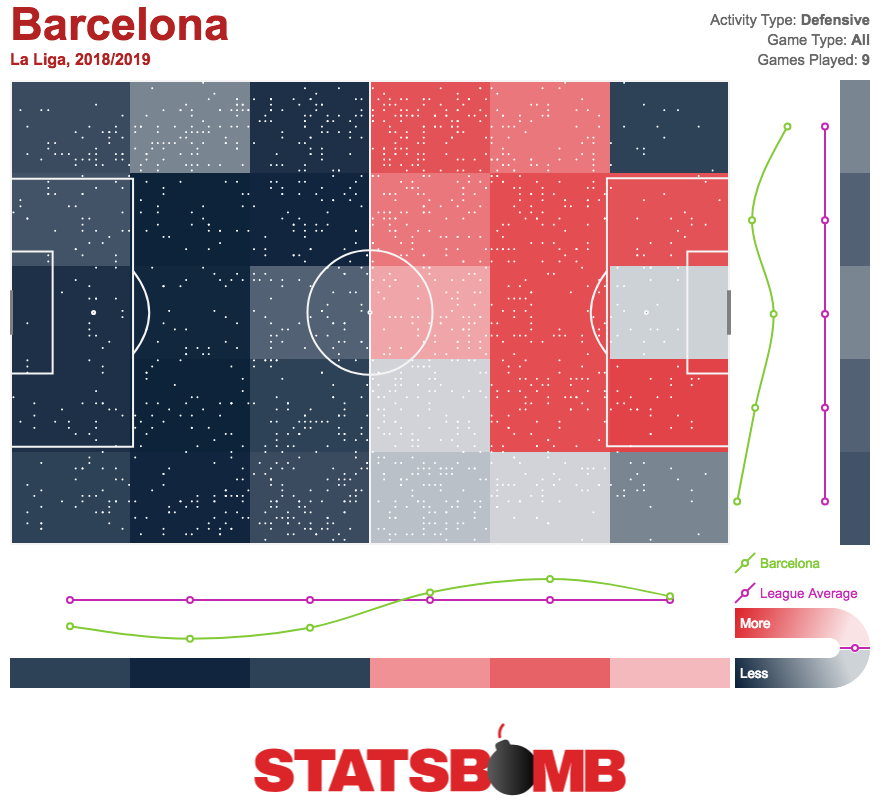 But while Barcelona are defending differently, it is not particularly clear that they are defending better. The xG per shot conceded has risen from 0.08 to a fairly horrific 0.14. No other side in La Liga has a figure this high. It’s worth saying that while Barcelona were still conceding chances last season, they were able to rely on the excellent form of Marc-Andre ter Stegen, rated the best shot stopper in La Liga last year by StatsBomb’s data. While last year’s significant defensive overperformance was unlikely to be repeated, even with such a high quality goalkeeper, it’s possible that the shift in style has not helped ter Stegen. He is now facing different types of shots from last season, fewer in frequency but harder to save. With Barca merely conceding as expected this year, it’s not unreasonable to wonder if ter Stegen might be less suited to making excellent saves in this kind of system, though it will take more games to be confident of this. The high pressing style is of course not unfamiliar to the Camp Nou faithful. The famous Barcelona team at the start of this decade managed by Pep Guardiola built there approach without the ball around a proactive attempt to win it back quickly, starting with Lionel Messi and the other forwards. Any team looking to instigate a high pressing approach would need to rely on a front line consistently harrying the opponent. But when looking at the players making the pressures for Barcelona, it is not the attackers doing the most work:
But while Barcelona are defending differently, it is not particularly clear that they are defending better. The xG per shot conceded has risen from 0.08 to a fairly horrific 0.14. No other side in La Liga has a figure this high. It’s worth saying that while Barcelona were still conceding chances last season, they were able to rely on the excellent form of Marc-Andre ter Stegen, rated the best shot stopper in La Liga last year by StatsBomb’s data. While last year’s significant defensive overperformance was unlikely to be repeated, even with such a high quality goalkeeper, it’s possible that the shift in style has not helped ter Stegen. He is now facing different types of shots from last season, fewer in frequency but harder to save. With Barca merely conceding as expected this year, it’s not unreasonable to wonder if ter Stegen might be less suited to making excellent saves in this kind of system, though it will take more games to be confident of this. The high pressing style is of course not unfamiliar to the Camp Nou faithful. The famous Barcelona team at the start of this decade managed by Pep Guardiola built there approach without the ball around a proactive attempt to win it back quickly, starting with Lionel Messi and the other forwards. Any team looking to instigate a high pressing approach would need to rely on a front line consistently harrying the opponent. But when looking at the players making the pressures for Barcelona, it is not the attackers doing the most work: 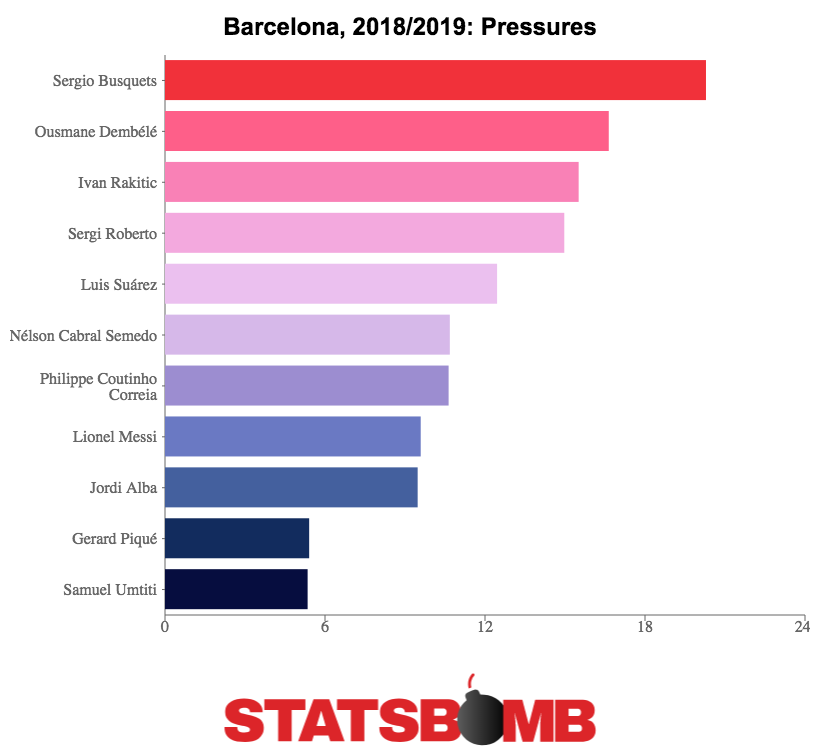 Holding midfielder Sergio Busquets is the only player making more than 20 pressures per 90. Of players that could very loosely be defined as attackers, it is only Ousmane Dembele appearing as a high volume presser. Luis Suarez, lauded in his Liverpool days for never stopping without the ball, is making just 12.45 pressures per 90, below average for a striker (albeit in a team with the majority of possession). Messi, truly the first line of defence in Guardiola’s side, is down among the least active players at 9.59. That both Suarez and Messi are now 31 years old may not be a coincidence here, and if the two of them cannot get through the pressing work that they once could, this could be a serious problem if Barcelona stick with the high press. When looking at the players pressing for Guardiola’s current club Manchester City, it is a different story. Bernardo Silva (who plays as both a more advanced central midfielder and in the front three) leads the way, followed by attackers Riyad Mahrez, Sergio Aguero and Gabriel Jesus. While his equivalent at Barcelona led the way, City’s holding midfielder Fernandinho is having to pressure the ball infrequently. The pressing in front of him is so good that he is rarely called upon. Busquets cannot say the same for the players in front of him at the Camp Nou.
Holding midfielder Sergio Busquets is the only player making more than 20 pressures per 90. Of players that could very loosely be defined as attackers, it is only Ousmane Dembele appearing as a high volume presser. Luis Suarez, lauded in his Liverpool days for never stopping without the ball, is making just 12.45 pressures per 90, below average for a striker (albeit in a team with the majority of possession). Messi, truly the first line of defence in Guardiola’s side, is down among the least active players at 9.59. That both Suarez and Messi are now 31 years old may not be a coincidence here, and if the two of them cannot get through the pressing work that they once could, this could be a serious problem if Barcelona stick with the high press. When looking at the players pressing for Guardiola’s current club Manchester City, it is a different story. Bernardo Silva (who plays as both a more advanced central midfielder and in the front three) leads the way, followed by attackers Riyad Mahrez, Sergio Aguero and Gabriel Jesus. While his equivalent at Barcelona led the way, City’s holding midfielder Fernandinho is having to pressure the ball infrequently. The pressing in front of him is so good that he is rarely called upon. Busquets cannot say the same for the players in front of him at the Camp Nou. 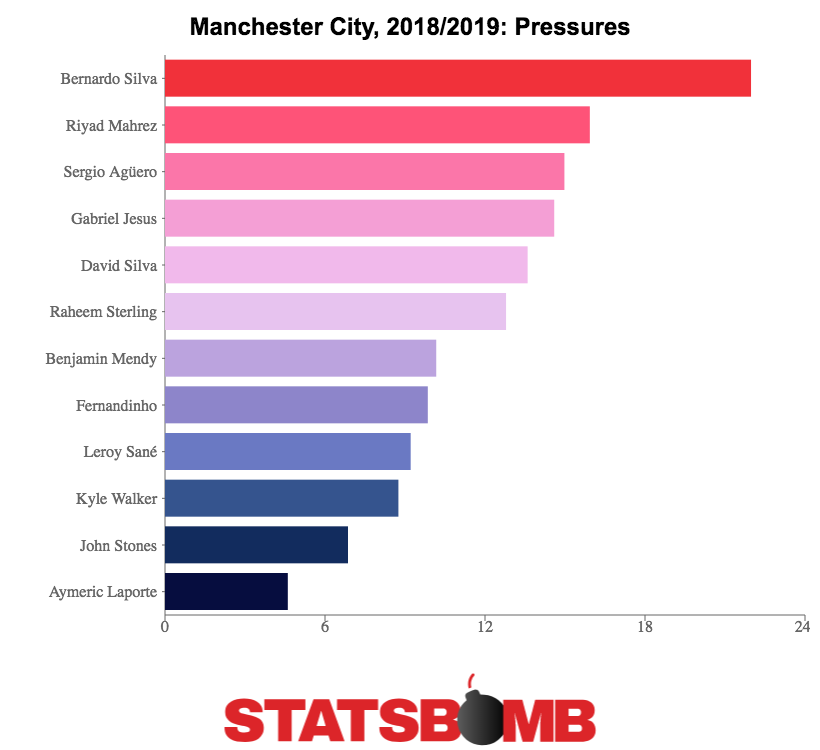
Attack
Let’s start by emphasizing, again, that expected goals still rates Barcelona’s attack as the best in La Liga, so any issues are by their standards and theirs alone. But still, there are issues. The attacking situation mirrors the defensive one in that everything looks great if you just look at raw shots. They’re taking a very healthy 17.89 of them per 90, a nice chunk more than last year’s 15.47. But, just as with the defence, the issue is not of quantity but quality. The xG per shot of 0.10 is middling for any side, but for Barcelona, it is downright uncharacteristic. As our fearless leader here at StatsBomb once said, “they just don’t take long range shots”. Or at least, they didn’t. Last year, 57% of the shots Barcelona took had an xG value of less than 0.10. This season, that figure is 64%. The shots they have added are mostly speculative efforts. It’s an effect that has happened across the team. When looking at their radars, it’s obvious that the side’s two primary shot generators, Messi and Suarez, just aren’t getting the same quality of chance as before: 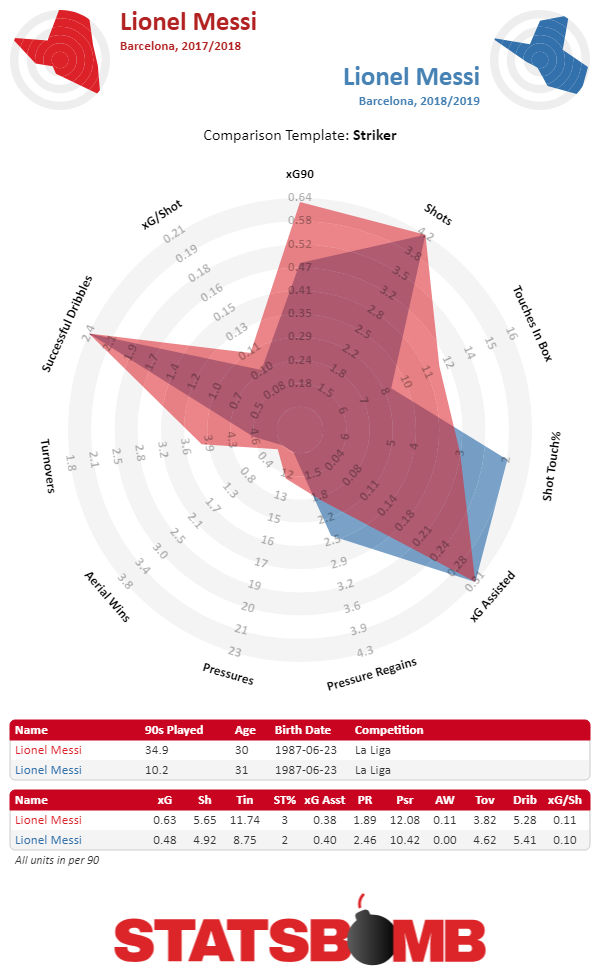
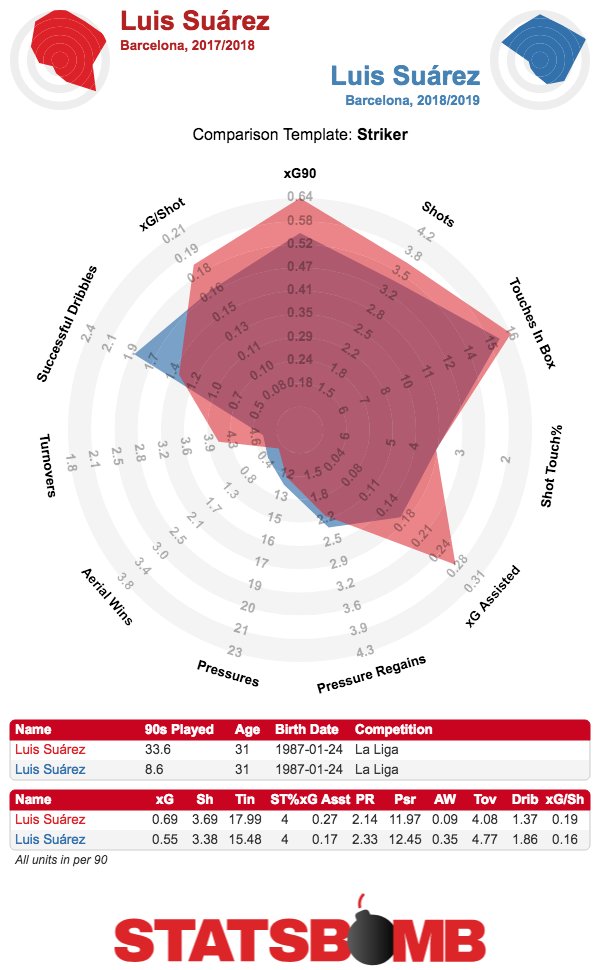 Looking at personnel changes, of course Andres Iniesta has been sold, but his skillset has been replaced fairly naturally by Philippe Coutinho. The one player who featured regularly last season and hasn’t seen a like for like replacement is Paulinho. No, seriously. Paulinho, though lacking in some other areas of the game, has shown in his career a great ability to get chances from excellent positions, with his xG per shot of 0.206 the highest of any Barcelona player last year.
Looking at personnel changes, of course Andres Iniesta has been sold, but his skillset has been replaced fairly naturally by Philippe Coutinho. The one player who featured regularly last season and hasn’t seen a like for like replacement is Paulinho. No, seriously. Paulinho, though lacking in some other areas of the game, has shown in his career a great ability to get chances from excellent positions, with his xG per shot of 0.206 the highest of any Barcelona player last year. 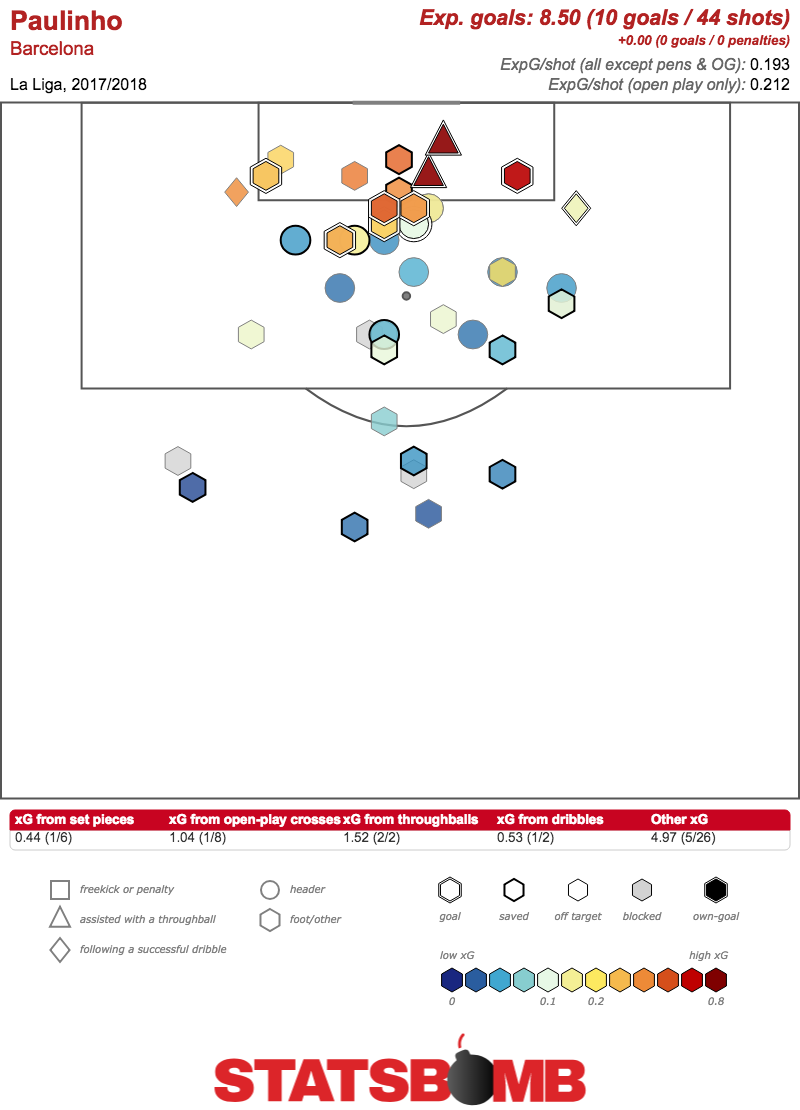 It is not just the goals Paulinho scored for himself, though. As Mike Goodman (who is editing this article, so any further compliments have been put in by himself) (ed. note--I would never!!) noted last season, “Paulinho’s primary job at Barça has been to charge forward from midfield into space and make runs that have the same kind of effect on a defense that a winger’s might. Time it right and get free for a pass, or suck the defense in and open up secondary options”. Barcelona do now have a genuine winger to make those kinds of runs in Dembele, fully integrated into the side after last year’s disrupted campaign. The Frenchman, though, has struggled to make the off the ball runs that the side requires, mostly functioning as more of a ball carrier with his dribbling threat. This is surely the most obvious solution to the team’s attacking issues. Dembele needs to look at the way Pedro used to play with Messi at the Camp Nou: doing most of his attacking work without the ball. Many others have had to curb their instincts to play with Messi, and Dembele needs to do the same in order to make this team tick.
It is not just the goals Paulinho scored for himself, though. As Mike Goodman (who is editing this article, so any further compliments have been put in by himself) (ed. note--I would never!!) noted last season, “Paulinho’s primary job at Barça has been to charge forward from midfield into space and make runs that have the same kind of effect on a defense that a winger’s might. Time it right and get free for a pass, or suck the defense in and open up secondary options”. Barcelona do now have a genuine winger to make those kinds of runs in Dembele, fully integrated into the side after last year’s disrupted campaign. The Frenchman, though, has struggled to make the off the ball runs that the side requires, mostly functioning as more of a ball carrier with his dribbling threat. This is surely the most obvious solution to the team’s attacking issues. Dembele needs to look at the way Pedro used to play with Messi at the Camp Nou: doing most of his attacking work without the ball. Many others have had to curb their instincts to play with Messi, and Dembele needs to do the same in order to make this team tick.
Conclusion
On both sides of the ball, it’s the same story: Barcelona have become all about dominating in terms of shot volume, and are paying the price in shot quality. Defensively, this seems to be due to a switch to a higher pressing system of which the suitability of the current personnel is debatable. In terms of the attack, the issue seems to be more about players’ specific roles, with no one quite filling the job Paulinho did last season as an additional runner into the box. In both cases, there are tactical tweaks that could help smooth things over, perhaps by turning the high press down a bit and adding an extra central midfielder for solidity, and by coaching Dembele into someone who can make more off the ball runs into the box (or trying Malcom if he can’t). These are, though, merely short term tweaks around the edges. There remains the elephant in the room of a squad getting worryingly old. Sir Alex Ferguson said that a football team should never be allowed to grow old together. Barcelona have found themselves in a position where the core of the side is built around Messi, Suarez, Ivan Rakitic, Busquets and Gerard Pique, all of whom are over the age of 30. Attempting to return to something closer to the old style of Guardiola isn’t paying dividends because the players can’t exert the same energy they once did for a high pressing system. While Valverde may find a way to patch things up for this season, the long term prospects for Barcelona do not look as strong as they have been for the past decade. Header image courtesy of the Press Association
